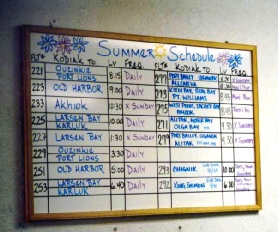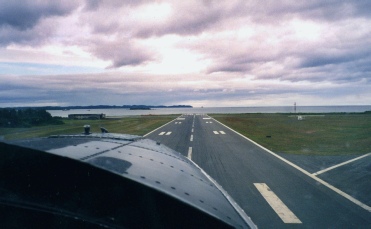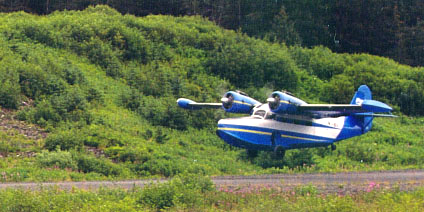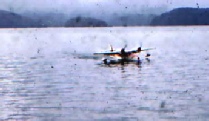
Peninsula Airways’ white Goose and Steve Harvey’s colorful Widgeon are parked together
on the tarmac at Kodiak’s main airport (ADQ) in the mid-
For this final article in the series of aviation stories, I turn to some recent experiences
in Kodiak, when I got to take my five and kids along and relive my childhood a bit,
taking a flight to well-
I also rely heavily on Fred Ball, who flew for Kodiak Western when my brother Kelly
worked there, and has kept me up to date on his adventures. I have some cool photos
of Fred Ball in action as he puts the PenAir Blue Goose through its paces, (and my
wife and family got to tag along) and have also included some spectacular photos
of Fred’s recent adventures with the Grumman amphibians in far-
Gooses at PenAir in the 1990’s, Including a Memorable Flight with Fred Ball in the Blue Goose


Two of PenAir’s Grumman Goose fleet were part of their operations in Kodiak in the late 1990’s. Fred Ball provided these photos of the planes in action around Kodiak Island. My family got to experience a water landing in the white Goose in 1996, and in 1998, we took a routine flight from Kodiak to Ouzinkie in the blue Goose, which Fred managed to make into an unforgettable adventure.
PenAir operated for many years in Kodiak, with a variety of aircraft, including Grumman amphibians. PenAir closed up shop in Kodiak shortly after I started making trips back home in the late 1990s’, but not before I had a few wonderful trips in their Gooses. The airline had two of them, a white plane with red and yellow trim with the more familiar fixed pontoons, and a blue and white one with fancy retractable pontoons that Fred Ball also flew. Fred Ball had worked for Kodiak Western (the last version of Kodiak Airways) in the 1970’s when my brother Kelly worked there, so they were old friends, and I had met him on several occasions on my trips north. On one return to Alaska, my family and I were headed to Ouzinkie to see Mom and I noticed with disappointment that the white Goose was not out on the tarmac.
Fred Ball came out of the office with a twinkle in his eye and motioned me around
behind the building. There were our suitcases being loaded into their beautiful
blue Goose! Knowing my obsession with picture-


Fred Ball (left) with my brother Kelly in 1997. Kelly had worked with Fred back in the last days of Kodiak Airways (Kodiak Western) in the 1970’s. On the right is PenAir’s summer schedule board from 1997.


Fred Ball does his preflight check and then we head down the runway at ADQ in the Blue Grumman Goose.
The kids look a little worried at first, but quickly warm to the adventure. Nate’s reaction in the photo on the right is about the same as mine!

As we near Ouzinkie, we buzz the M/V Tustumena, distorted a bit in the pilot’s bubble window. I’m sure the old Goose was a grand sight to see for her passengers, as well.


Fred prepares the Goose for a landing on the KOZ gravel airstrip, then prepares to take off again. The only disappointment is that nobody lands in the bay anymore since the airstrip went in.


Steve Harvey and His Widgeon: The Tradition Continues!


Top: Steve continues the family tradition, ferrying hunters and fishermen to remote sites around Kodiak Island. What a gorgeous day for flying! Incidentally, when the weather is bad, nobody is out flying, so you hardly ever see a photo of Kodiak aircraft in the wind and rain!
Left: No wonder Steve has such a big smile on his face! What a great profession to be in, flying a classic plane in and out of beautiful territory with appreciative passengers! (Both photos provided in 2010 by Steve)
(Official Harvey Flying Service photo) This gorgeous shot of the Harvey Flying Service Widgeon also graces the logo of Steve’s web page. It was taken on a flight to the mainland in 2003. N17481 looks just as pretty as the day it was made!
Far-
Fred Ball has one of the best jobs around, as the photos below will attest. Fred
keeps himself occupied as a flight instructor for various Goose and Widgeon owners,
and also conducts annual inspections for Grumman owners. Recently, I was searching
on YouTube, and there was Fred, delivering a Widgeon to its new owner. He did an
impressive fly-



Above: Here’s a Goose that Fred flew down from San Jose to Cabo San Lucas, Mexico and then up to Seattle (he got to fly it for ten days).
Right: I’ll bet the plane is getting more attention than the fake pirate ship! Fred is on our left, next to a fellow pilot and the lucky owner of the Goose.
Top: This beauty belongs to a man in Ireland. Fred Ball went to Ireland to fly it and train other pilots.
Bottom: Here the Goose holds its own against a vintage World War II fighter. The Goose airframe is actually an older design.



Right: the Goose floats in an Irish lake, Lough Ree. I hardly notice the nice yacht!
Below: A man’s home is his castle, and this man not only has a castle, but a vintage Grumman Goose. Nice! This is Ashford Castle on the Lough Comb west of the River Shannon north of Galway. Well, Mr. Ball, there are only a few things in life that would keep me from noticing a castle, and you found one!


Here the Goose looks almost cosmic against the backdrop of the jet contrails in the sunset. Ireland is an even more lovely place thanks to this splendid Goose.

Fred tells the story of the lovely Widgeon in the photos below:
I checked out a Widgeon that was stuck in the alder brush in North Naknek (Alaska) a few years back. It was disassembled, put into a container and is now flying out of Battle Ground Washington.
I was at the Boulder City, Nevada “seaplane fly-

It’s hard to believe that this beautiful aircraft flying near Boulder City was a pile of scrap for several decades! Hats off to the dedicated souls who keep these planes flying (and floating)!

Fred Ball sent me this self-
Closing Thoughts:

This shot scanned from official Grumman literature during World War II (and obviously posed!) brings us back to the Goose and Widgeon’s original purpose, to serve as scout and rescue planes for the US Navy. It is a happy fact that the amphibians have long exceeded their original purpose, beyond the wildest imaginations of their designers.

This dramatic Dirk Sundbaum shot captures a Goose taking off with Near Island in the background. But look closely: the tail shows two different paint jobs, a visible symbol of the ingenuity of those dedicated mechanics in keeping the old birds aloft and functioning properly.
Above is the Kodiak Airways hangar, where planes were put back together. The cleared area in the foreground is the lake end of the KDK airstrip.
On the right is a shot of a Goose (red and white) and Widgeon in various stages of repair. Aviators must have had a very high opinion of the Grumman Goose and Widgeon amphibians over the years, not only in Alaska but in many other areas of the world, to have kept them in constant use since the late 1930’s.



Catalina Island, California, 2004 — Left: The front of a store in Avalon pays tribute to the Grumman Goose, used by Catalina Airlines for many years to connect Avalon to the mainland. Kodiak Airways’ first Goose was bought from Catalina Airlines.
Right: I happened to be visiting Catalina when Avalon was host to a Goose pilots’ reunion, and I posed in front of one of several planes that were flown in just for the occasion. The palm trees and warm California breezes are a far cry from the spruces and crisp air of Kodiak, but the sentiments toward the old Grummans were shared by all.

It’s a tiny and blurry picture from long ago, but it has a big story to tell. This slide from the 1960’s shows a Kodiak Airways Grumman amphibian plane taxiing up to a cannery on the north end of the Kodiak Island archipelago. It’s old and fuzzy and indistinct, like a distant memory. But for those of us who grew up in rural Alaska, around those old planes, the photo captures the excitement and emotion of getting mail, finding a way home, or heading off to an entirely new experience in a strange and wild place. Like the paddle wheelers, stagecoaches, and steam locomotives of old, the Grummans represent a link to the old and familiar, and a gateway to a world of adventure. And like the photo, they are slowly fading from view.
For many of us who lived in the remote areas, the bush pilots and their planes were
our only regular link to the outside world. And in many places and situations in
Alaska, it’s still that way. One bush pilot told me about a large group of hunters
who got stranded at the far end of the island after the terrorist attacks of 9-
When the first float plane arrived to remove the hunters, they were angrily waiting on the beach, thinking that the air service had been negligent or incompetent. They had spent two extra days (in good weather, no less) awaiting planes that never came, and none of them had any radios or sat phones. Their reaction, when they heard the reason for the delay, was shock and dismay, and a complete understanding of the pilots’ dilemma. But it underscores the point, that there are times when somebody’s bush plane is still your only lifeline to the rest of the planet. No wonder the planes that served as our vital links in years gone by have such an emotional hold on us!
— Timothy Smith, July 2011, revised February 2020
For more on Kodiak aviation, including much more information
on the Goose and Widgeon, and many more historic photos,
please follow the links below.
Still Flying (Grumman Goose and Widgeon in Recent Adventures)
By Timothy Smith, Originally posted in 2011, latest revision in 2020
Goose and Widgeon: Still Flying!
Last in a series of articles that includes “Goose Stories,” “More Amphibian Adventures,” “Runways to Remember,” and “From Shore to Sky”
Featuring Recent Adventures of Steve Harvey and Fred Ball


Fred’s Fantastic Flyby:
When Fred Ball left us at the airstrip in Ouzinkie, he said, “Tim, keep your camera handy!”
Fred retracts the wheels while still above the runway, and takes off like normal.
But he turns around over the bay and buzzes the runway in the opposite direction, before heading back to town.


Steve Harvey’s dad, Bill Harvey, peers out the hatch of his Widgeon, surrounded by a group of hunters, in this photo from the early 1960’s. Inset: the same hunting party loading the Widgeon. Harvey Flying Service continues today in the capable hands of Steve, featuring his own pristine Grumman Widgeon.

Steve Harvey poses beside his Widgeon as it receives some maintenance in the PenAir hangar in this 1998 photo.
As local Kodiak bush pilots go, Steve Harvey is a legend. He is by no means the only
second-
As I have written these articles over the last twenty years, I have frequently called him and emailed him with stacks of questions. Between flights at the height of bear hunting season, he provided anecdotes and corrections and a good many vintage photos as well. He protests that he’s a “pilot, not a writer,” but his passion for the great old planes and for the history of aviation in Kodiak is unmistakable, and borders on poetic. I get it. I love those old planes and old stories, too, and I’m not even a pilot. And now, since PenAir pulled out of the Kodiak market and took their Grummans with them, Steve’s Widgeon is just about the only working survivor of a long legacy in Kodiak aviation. Below, he lets his photographs tell the story of just a few of his adventures in his wonderful Widgeon.

The Harvey Flying Service Widgeon departs Danger Bay in this 1981 photo. You can see the wake stretching almost to the beach.

Steve Harvey pulls up on the beach in Ouzinkie in this 1982 photo. The sound of a
Grumman attempting to navigate up the beach, then turn around on the soft beach
sand, can be as loud as when it takes off! It’s an inefficient dune buggy, but unrivaled
for getting heavy loads in and out of remote locations. Not bad for a late-







To Find Out More About Tanignak.com, Click HERE
To Visit My “About Me” Page, Click HERE
To Return to Tanignak “Home,” Click the Logo Below:
Information from this site can be used for non-

